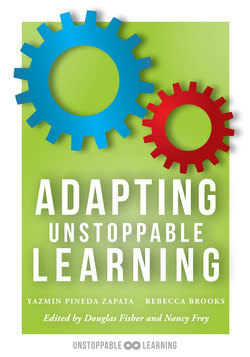Читать книгу Adapting Unstoppable Learning - Rebecca Brooks - Страница 9
На сайте Литреса книга снята с продажи.
ОглавлениеForeword
By Douglas Fisher and Nancy Frey
Education begs for equity. In 1975, Congress passed Public Law 94–142 (Education for All Handicapped Children Act, 1975), ensuring that youth with disabilities could attend school. Ten years before that, Congress passed the first version of the Elementary and Secondary Education Act (1965), whose current version is known as the Every Student Succeeds Act, or ESSA (2015). These acts increase efforts for students who live in poverty as well as those who struggle with school. The stage was set, legally, for students with disabilities to receive a free and appropriate public education. School systems work to educate students to the maximum extent possible, with appropriate supports and services.
Before continuing, we should let you know that we have been labeled radical inclusionists. That label makes us proud even though those who label us do so disparagingly. We believe so strongly that students with and without disabilities should be educated together that in 2007, we started a new high school where exactly that occurs. We strongly support inclusion and believe that the regular classroom is the least restrictive environment. Providing students what they need to be successful is the right thing to do.
But simply placing students who struggle in general education classes without support dooms them to fail. Congress knew that back in 1975, and many educators are still learning that lesson today. Many learning environments are not conducive to the success of students who struggle with learning or physical disabilities, which is where curriculum and technology support come into play. Some students also need support with behavior, personal care, health, and so on. Some students simply struggle with one topic during an entire academic year’s worth of topics. The fact is, the law requires that school systems provide support so that students can be successful in the general classroom. Educators have to design appropriate supports and services before recommending that a student be considered for an alternative environment.
Of course, our collective understanding of how to support students who struggle has changed considerably. Over the past several decades, there have been breakthroughs for developing accommodations and modifications. This book contains relevant, current information about the techniques that general and special educators can use to support students’ learning needs. It’s full of tried and true approaches, as well as new technologies, for supporting students in the general classroom.
Importantly, when done well, the positive effects of accommodations and supports for struggling students spill over and impact other students. We have seen countless students better understand a complex concept after seeing the modified version of the learning target. We also have seen teachers change their lessons based on the accommodations that were intended for students. Sometimes, the accommodations and modifications are better than the original curriculum and everyone learns more—but that’s not the main goal of providing curricular, personal, or technological support. The real intention is curriculum accessibility for all students, and that depends on educators having sufficient knowledge to design and redesign learning tasks that all students can access.
It is important that the accommodations and modifications ensure that the tasks remain challenging but not out of reach. That’s a delicate balance that Yazmin Pineda Zapata and Rebecca Brooks tackle with skill. They provide a wide range of both imagined and real-life examples and ideas that educators can apply to ensure that students receiving support are accountable for their learning and that the support team maintains high expectations and rigor. This book contains the tools that educators need to make learning unstoppable for all students.
